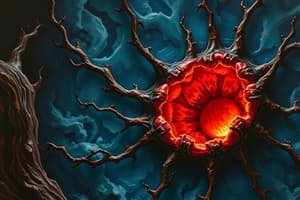Podcast
Questions and Answers
two ways in which the death of cells can occur
two ways in which the death of cells can occur
necrosis apoptosis
changes produced by enzymatic digestion of dead cellular elements; irreversible injury
changes produced by enzymatic digestion of dead cellular elements; irreversible injury
necrosis
vital process that helps eliminate unwanted cells
vital process that helps eliminate unwanted cells
apoptosis
types of necrosis
types of necrosis
characterized by deposition of fibrin-like proteinaceous material in walls of arteries
characterized by deposition of fibrin-like proteinaceous material in walls of arteries
liberation of pancreatic enzymes with auto-digestion of pancreatic parenchyma; trauma to fat cells
liberation of pancreatic enzymes with auto-digestion of pancreatic parenchyma; trauma to fat cells
typically seen in hypoxic envi.; outline of dead cells maintain while the tissue somewhat firm
typically seen in hypoxic envi.; outline of dead cells maintain while the tissue somewhat firm
dead cells undergo disintegration and affected tissue liquified
dead cells undergo disintegration and affected tissue liquified
specific form if coagulation necrosis caused by mycobacteria; both lique and coag necrosis
specific form if coagulation necrosis caused by mycobacteria; both lique and coag necrosis
these are usuallly superimposed infection; secondary to ischemia
these are usuallly superimposed infection; secondary to ischemia
restricted to necrosis involving spirochaetal infections
restricted to necrosis involving spirochaetal infections
this is due to blockage of the venous drainage of organ or tissue
this is due to blockage of the venous drainage of organ or tissue
how many cells produced every second by mitosis and similar number die by apoptosis
how many cells produced every second by mitosis and similar number die by apoptosis
two causes of apoptosis
two causes of apoptosis
Flashcards
Necrosis
Necrosis
The death of cells due to irreversible injury, characterized by enzymatic digestion of dead cellular elements.
Apoptosis
Apoptosis
A vital cellular process that eliminates unwanted cells in a controlled manner.
Coagulative necrosis
Coagulative necrosis
A type of necrosis where the outline of dead cells is preserved, but the tissue is firm.
Liquefactive necrosis
Liquefactive necrosis
Signup and view all the flashcards
Caseous necrosis
Caseous necrosis
Signup and view all the flashcards
Gangrenous necrosis
Gangrenous necrosis
Signup and view all the flashcards
Fibrinoid necrosis
Fibrinoid necrosis
Signup and view all the flashcards
Fat necrosis
Fat necrosis
Signup and view all the flashcards
Haemorrhagic necrosis
Haemorrhagic necrosis
Signup and view all the flashcards
Physiologic apoptosis
Physiologic apoptosis
Signup and view all the flashcards
Pathologic apoptosis
Pathologic apoptosis
Signup and view all the flashcards
Mitosis cell production
Mitosis cell production
Signup and view all the flashcards
Apoptosis cell death
Apoptosis cell death
Signup and view all the flashcards
Cell death rate
Cell death rate
Signup and view all the flashcards




